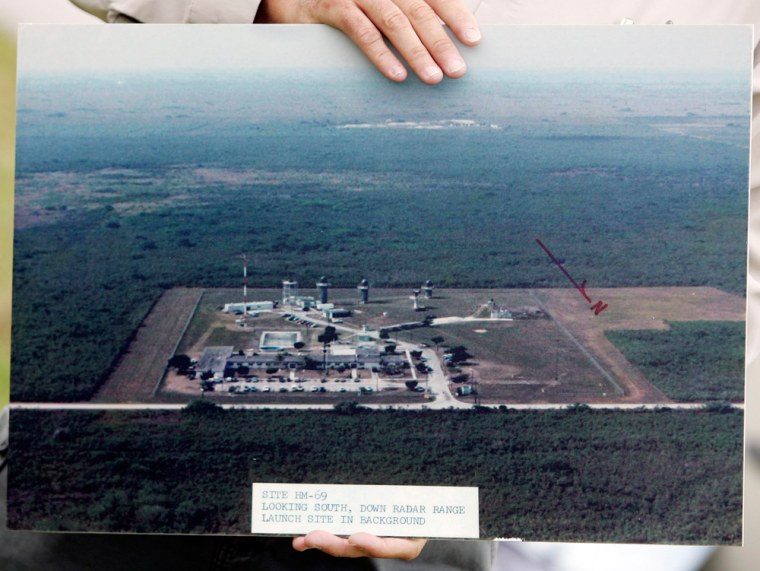At the height of the Cold War, anti-aircraft missiles stood at the ready here in Florida's swamplands, protecting the South from a potential Soviet nuclear bomber attack launched from Cuba.
For almost two decades, beginning shortly after the 1962 Cuban Missile Crisis, the HM-69 Nike Hercules Missile Site was manned by about 100 military personnel, one of the last lines of defense if the unthinkable happened. When it closed in 1979, the park took control of the site.
Now the site is undergoing a rebirth of sorts as a public exhibit, drawing the curious who want to see the Cold War relic along with those who stumble upon it while visiting Everglades National Park.
With a $10 Everglades admission fee and a phone call to park officials, tourists can join the hour-long driving tour of the Nike site, which was included on the National Register of Historic Places in 2004. Although the missiles were dismantled and removed, visitors can see the site's administration building, the tiny missile assembly shed, the missile barns and protective berms. Tours continue through March, during the park's peak season.
In plain view
Sites like this sprung up during the Cold War to defend U.S. cities from attack and send the Soviets a message of strength. The missiles in South Florida were certainly not hidden — at 41 feet tall, anyone could see them. While some Nike missiles were nuclear-tipped, Air Force spokesman Lt. Col. Tadd Sholtis said the weapons at the Everglades site probably weren't.
"You could just drive down the road and see them setting out there," said Bobby Jones, who was transferred to the site in 1965, when it was still a temporary operation. "The missiles were setting on trailers. ... everything was mobile. We could move within an hour. The radar and everything."
Jones repaired diesel generators used to power the site, including its radar system and missile launchers. He remembers the wild birds and alligators that he shared the land with, and the porous ground that the site was built upon.
"I had never seen anything like South Florida before in my life," said Jones, who was from Missouri. "It was all really new to me. And I was fascinated with the wildlife there."
‘Our appreciation for them is evolving’
Park officials said interest has been high in the landmark, which takes on a greater relevance this year, the 50th anniversary of the Cuban Revolution. They have already added an extra day to the tour schedule.
"I think certainly in this community, what people focus on is how things were doing the Cuban Missile Crisis. And a lot of our demographics are interested in the history of our dealings with Cuba," said Melissa Memory, chief of cultural resources at the park. "But I think in the broader preservation community, Cold War historic assets, our appreciation for them is evolving."
Because the site was placed inside a national park, it has survived urban expansion and is now well-preserved, said volunteer tour guide Gregg Halpin.
Other Nike sites scattered around the United States, strategically placed near cities, have disappeared. As the threat of a Soviet attack faded, many of the sites (after the missiles were removed) were integrated into urban communities as parks or business centers.
In Arlington Heights, Ill., a former Nike base is now an 18-hole golf course. A New Jersey town proposed converting its former base into a commuter parking lot in December. And part of an old site in Gardner, Kan., has been converted into Nike Elementary School. The school's nickname: the Missiles.
The Nike site tucked away in the Everglades was not the only one in Florida. The former launch area of the Nike Hercules Site HM in Opa-Locka, just north of Miami, is now a National Guard reservation. Another site in Miami has become an Immigration and Naturalization Service facility.
The Everglades site is now searching for information, historic replicas and artifacts used at the facility during the Cold War to include in the tour. Park officials are also working to spruce up areas that have not yet been open to the public because of health and safety concerns, and are conducting interviews with former military personnel who were stationed here.
"We can go on the Internet and other research is available to us, so we know who built (it) and when it was built," Halpin said. "But we need those personal stories to make it a connection with the people, so the people will want to come here and see what it was all about."
If you go
Nike Missile Site tours: Everglades National Park
Tours are offered Saturdays and Sundays at 2 p.m. through the end of March, but they are filling up fast. The tours depart from the Ernest Coe Visitor Center, 9 miles southwest of Homestead, Fla., on State Road 9336.
Reservations are taken at the Ernest Coe Visitor Center up to 30 minutes before each tour or by calling 305-242-7700, ext. 7300. Participants must arrive in the park by 1:30 p.m. and be prepared to drive 14 miles round trip from the visitor center.
